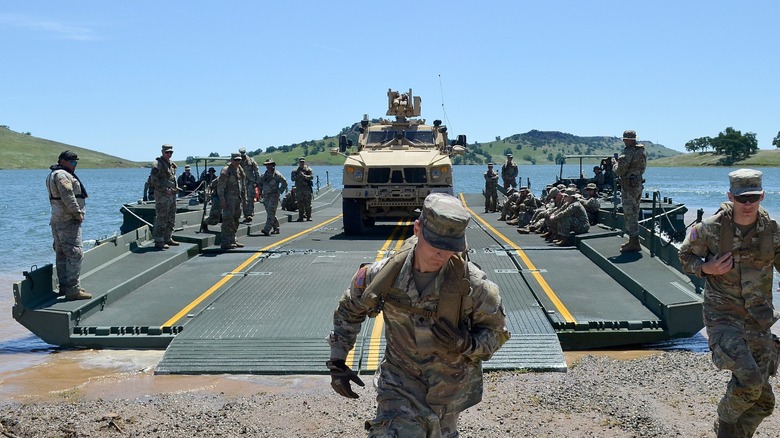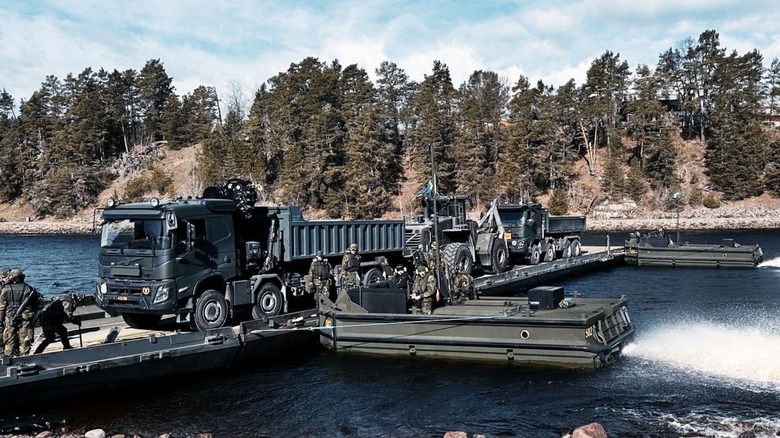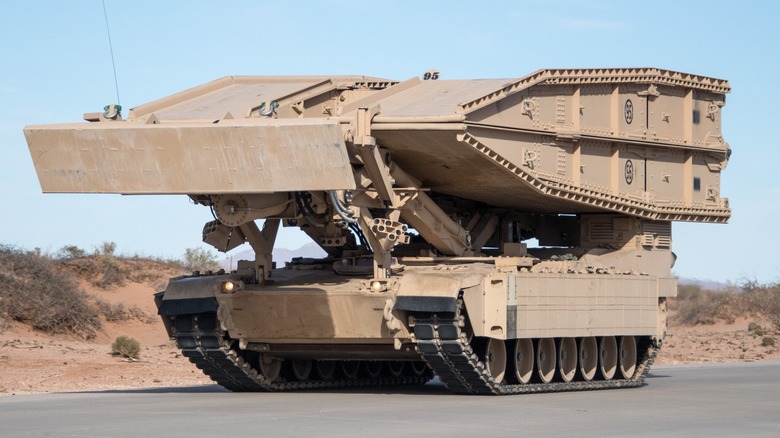How The US Army Builds Bridges That Can Carry Tanks In A Matter Of Minutes
Rivers have been used as natural barriers during warfare throughout history, as well as in present day. In the Russo-Ukrainian war, for example, the Dnipro River in southern Ukraine serves as a buffer dividing opposing military lines. Crossing rivers is challenging in conflicts, especially considering some can extend more than a mile wide. However, there are several options militaries use when they need to move their forces across a river, including vehicles that serve as makeshift bridges.
The technology goes back to World War I, when the tank was first used in combat on European battlefields. It became apparent early in the conflict that tanks were incapable of crossing rivers on their own, so the British Army found a solution in the Inglis Portable Military Bridge. Early efforts were fairly rudimentary, but by World War II, most armies had a means of moving their heavy equipment across rivers.
When the crossing is complete, these bridge can be folded up and reused down the line. It only takes a few minutes to put in place or take down. The U.S. Army's M104 Wolverine "Heavy Assault Bridge" provided this service for many years, as will its replacement, the M1074 Joint Assault Bridge (JAB). Both are built on the hull of the General Dynamics-produced M1 Abrams Tank.
The Improved Ribbon Bridge crosses rivers with ease
Heavy bridge-laying equipment certainly comes in handy, but another type of bridge can help move Army assets across wider waterways. The Improved Ribbon Bridge (IRB) (pictured) doesn't merely enable units to cross large waterways; it can also be used as a floating bridge or multi-bay ferry. Multiple segments can be combined to make the unit longer, with 9.94 miles of IRB in service around the world.
The bridge components are transportable on just about anything that drives or flies and can handle their size. It's even operable in waters moving up to 9.84 feet per second. The IRB is also fully functional when paired with NATO-standard systems, as well as the older Standard Ribbon Bridge and Floating Support Bridge systems. Because IRB floats and is easily transportable, it makes it easy to use and set up for all kinds of crossing operations. This system can even support simultaneous two-lane traffic and can be used by tracked and wheeled vehicles alike.
The U.S. Army's heavy bridge-laying equipment
The IRB is an excellent system for most vehicles, but when it comes time to move something like an M1A2 Abrams Main Battle Tank — widely considered one of the best tanks ever made — the Army needs to look to more traditional, armored bridge-laying equipment. It has plenty of vehicles that are capable of constructing a bridge rapidly. The M60 AVLB was introduced in the early 1960s, but the M104 Wolverine took much of its workload when it made its debut in the early 2000s. The Wolverine is a robust system that can unfold its bridge across a nearly 79-foot gap. It can withstand 5,000 crossings of 70-ton vehicles, including tanks. The system can also usually launch and retrieve around 2,200 times without needing any repairs, so it's reliable.
The M1074 JAB was first introduced in 2016 to phase out some of the older equipment. It takes between three and five minutes to launch and between six and 10 minutes to retrieve. Weighing around 68.7 tons, the JAB has a scissor bridge length of about 42 feet. Unlike the M1 Abrams Main Battle Tank, which requires four personnel to operate, the M1074 JAB only needs two enlisted service members. In addition to IRB, these bridge-laying vehicles ensures no river is to wide to cross.


